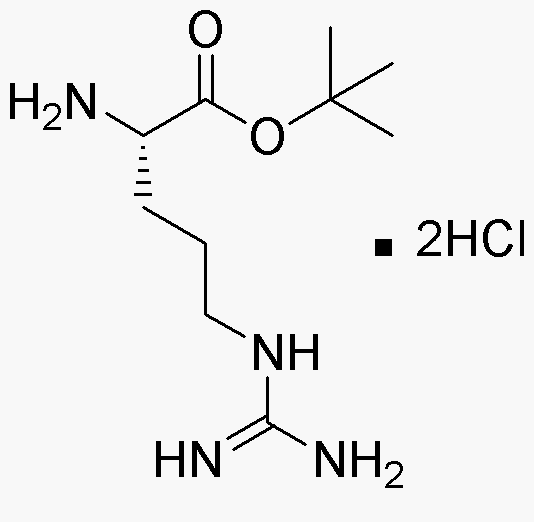L-Arginine-tert-butyl ester dihydrochloride is widely utilized in research focused on:
- Pharmaceutical Development: This compound serves as a precursor in the synthesis of nitric oxide donors, which are crucial in developing treatments for cardiovascular diseases.
- Biochemical Research: It is used in studies investigating the role of arginine in protein synthesis and cell signaling, providing insights into metabolic pathways.
- Cosmetic Formulations: The compound is incorporated into skincare products for its moisturizing properties, enhancing skin hydration and elasticity.
- Nutrition Supplements: It is often included in dietary supplements aimed at improving athletic performance and recovery due to its role in enhancing blood flow and nutrient delivery.
- Cell Culture Applications: This chemical is utilized in cell culture media to support the growth of various cell types, particularly in studies related to cancer and regenerative medicine.
General Information
Properties
Safety and Regulations
Applications
L-Arginine-tert-butyl ester dihydrochloride is widely utilized in research focused on:
- Pharmaceutical Development: This compound serves as a precursor in the synthesis of nitric oxide donors, which are crucial in developing treatments for cardiovascular diseases.
- Biochemical Research: It is used in studies investigating the role of arginine in protein synthesis and cell signaling, providing insights into metabolic pathways.
- Cosmetic Formulations: The compound is incorporated into skincare products for its moisturizing properties, enhancing skin hydration and elasticity.
- Nutrition Supplements: It is often included in dietary supplements aimed at improving athletic performance and recovery due to its role in enhancing blood flow and nutrient delivery.
- Cell Culture Applications: This chemical is utilized in cell culture media to support the growth of various cell types, particularly in studies related to cancer and regenerative medicine.
Documents
Safety Data Sheets (SDS)
The SDS provides comprehensive safety information on handling, storage, and disposal of the product.
Product Specification (PS)
The PS provides a comprehensive breakdown of the product’s properties, including chemical composition, physical state, purity, and storage requirements. It also details acceptable quality ranges and the product's intended applications.
Certificates of Analysis (COA)
Search for Certificates of Analysis (COA) by entering the products Lot Number. Lot and Batch Numbers can be found on a product’s label following the words ‘Lot’ or ‘Batch’.
*Catalog Number
*Lot Number
Certificates Of Origin (COO)
This COO confirms the country where the product was manufactured, and also details the materials and components used in it and whether it is derived from natural, synthetic, or other specific sources. This certificate may be required for customs, trade, and regulatory compliance.
*Catalog Number
*Lot Number
Safety Data Sheets (SDS)
The SDS provides comprehensive safety information on handling, storage, and disposal of the product.
DownloadProduct Specification (PS)
The PS provides a comprehensive breakdown of the product’s properties, including chemical composition, physical state, purity, and storage requirements. It also details acceptable quality ranges and the product's intended applications.
DownloadCertificates of Analysis (COA)
Search for Certificates of Analysis (COA) by entering the products Lot Number. Lot and Batch Numbers can be found on a product’s label following the words ‘Lot’ or ‘Batch’.
*Catalog Number
*Lot Number
Certificates Of Origin (COO)
This COO confirms the country where the product was manufactured, and also details the materials and components used in it and whether it is derived from natural, synthetic, or other specific sources. This certificate may be required for customs, trade, and regulatory compliance.


